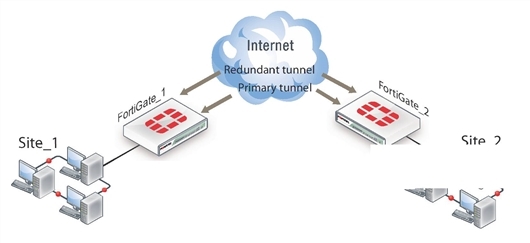Configuration overview
A FortiGate unit with two interfaces connected to the Internet can be configured to support redundant VPNs to the same remote peer. If the primary connection fails, the FortiGate unit can establish a VPN using the other connection.
Redundant tunnels do not support Tunnel Mode or manual keys. You must use Interface Mode.
A fully-redundant configuration requires redundant connections to the Internet on both peers. The figure below shows an example of this. This is useful to create a reliable connection between two FortiGate units with static IP addresses.
When only one peer has redundant connections, the configuration is partially-redundant. For an example of this, see Configuration overview. This is useful to provide reliable service from a FortiGate unit with static IP addresses that accepts connections from dialup IPsec VPN clients.
In a fully-redundant VPN configuration with two interfaces on each peer, four distinct paths are possible for VPN traffic from end to end. Each interface on a peer can communicate with both interfaces on the other peer. This ensures that a VPN will be available as long as each peer has one working connection to the Internet.
You configure a VPN and an entry in the routing table for each of the four paths. All of these VPNs are ready to carry data. You set different routing distances for each route and only the shortest distance route is used. If this route fails, the route with the next shortest distance is used.
The redundant configurations described in this chapter use route-based VPNs, otherwise known as virtual IPsec interfaces. This means that the FortiGate unit must operate in NAT mode. You must use auto-keying. A VPN that is created using manual keys cannot be included in a redundant-tunnel configuration.
The configuration described here assumes that your redundant VPNs are essentially equal in cost and capability. When the original VPN returns to service, traffic continues to use the replacement VPN until the replacement VPN fails. If your redundant VPN uses more expensive facilities, you want to use it only as a backup while the main VPN is down. For information on how to do this, see Configuration overview.
Example redundant-tunnel configuration

A VPN that is created using manual keys cannot be included in a redundant-tunnel configuration.

